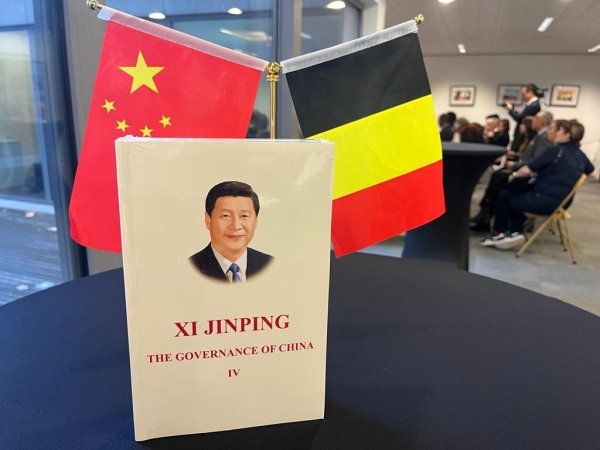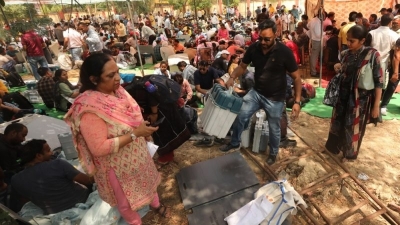Belt & Road, and President Xi Jinping’s ‘The Governance of China’

The strategy initiated by the People’s Republic of China seeks to connect Asia with Africa and Europe via land and maritime networks with the aim of improving regional integration, increasing trade and stimulating economic growth.
The idea was to create a vast network of railways, energy pipelines, highways, and streamlined border crossings, both westward—through the mountainous former Soviet republics—and southward, to Pakistan, India, and the rest of South-East Asia.

The project has led to the creation of 420,000 new jobs and now comprises 150 countries, it was said at the “10th anniversary symposium” in Brussels.
The upbeat message to emerge from the event was timely as the scheme celebrates its tenth anniversary this year.
The project was first called the ‘One Belt, One Road’ initiative, then finally the Belt and Road Initiative. The idea was first proposed by Chinese President Xi Jinping during a visit to Kazakhstan in 2013.
AdvertisementThe press club event was also a chance to launch the fourth volume of a book by Chinese President Xi Jinping, in which he outlines his hopes for a “better understanding” of China which, he says, is now entering a “new era.”

A range of speakers, from the world of diplomacy, politics, business and academia, praised the Belt and Road initiative while also accepting there had been some initial “doubts” and “suspicions”, particularly in the West, about the possible motives behind the scheme.
The original Silk Road arose during the westward expansion of China’s Han Dynasty (206 BCE–220 CE), which forged trade networks throughout what are today the Central Asian countries of Afghanistan, Kazakhstan, Kyrgyzstan, Tajikistan, Turkmenistan, and Uzbekistan, as well as modern-day India and Pakistan to the south.
A keynote speaker at the event, Wu Gang, minister counsellor at the Chinese embassy in Belgium, told the audience (28 November) that his country was no longer poverty-stricken but, rather, a “modern and prosperous society”.
There had been a “great transformation” and China, he noted, was now about to enter a “critical stage” of its development.
Turning to the Chinese president’s book, “The Governance of China” he said it sought to address “four questions” about China, the world, its peoples and “the times” we live in.
The hope is that an exhaustive book will “help create a better understanding of China” and foster more cooperation.

He said, “There is no universal model for modernisation but, bearing in mind that China is huge, ours is based on common prosperity and harmony.”
The Belt & Road Initiative, he said, was a “major step” along this route and was the “largest cooperation platform” in the world which seeks to foster “unity and cooperation.”
He added, “We look forward to further similar cooperation over the next decade.”
Another speaker was Vincent De Saedeleer, deputy managing director of CSP Zeebrugge Terminal and vice president of Cosco Belgium, a Chinese maritime company.
He told the debate that the Belt & Road project, an increasingly important umbrella mechanism for China’s bilateral trade with BRI partners, had survived several “hurdles” including economic and health crises and was now helping to promote global trade.
He admitted, “Yes, it takes time and everything cannot be achieved at once but there has been a great effort by China to become more open and make its markets more transparent.”
The Belgian added, “There is a willingness by China to be a market player and there have been a lot of improvements in the decade since the scheme was started.”
Warning of a “growing rivalry” between the U.S. and China, he said, “The world faces enormous problems so we should not seek to escalate this.”
Academic Bart Dessein, a professor at the University of Gent, was another guest speaker and he outlined what he called some of the direct achievements of the Belt & Road Initiative, saying its 3,000 projects had led to the creation of 420,000 jobs worldwide.
The world, he said, originally saw the scheme as a “grand strategy” by China and had viewed it at first with “some suspicion.”
“In fact,” he noted, “the scheme is just a continuation of the same policy China has been developing since the 1970s.”
He said, “It is not some sort of ‘master plan’ to be feared but is, in fact, a very, very local initiative and is directly related to ‘the people’ as the president mentions in his new book.”
“There is a tendency by some to put China in the ‘enemy camp’ but the world is more complex than that and I believe that China wants to be a responsible stakeholder.”
Colin Stevens, publisher of EUReporter, which helped organise the event, reminded the audience that the Belt & Road Initiative sought to revive the old Silk Road routes in Asia and “enhance” global trade.
He also pointed to a new partnership his company had launched with CMG, a Chinese state-owned conglomerate which, he said, would also help “bridge cultural gaps” between the West and China.
Elsewhere, Nick Powell, Political Editor at EUReporter, noted that the Chinese president’s book had been published at a time when “relations with China are particularly in focus.”
He too said that while the Belt & Road Initiative, one of the most ambitious infrastructure projects ever conceived, had been met initially with some scepticism in some quarters it had, so far, proved a success.
Bernard Dewit, Chairman of the Belgian-Chinese Chamber of Commerce (BCECC), who opened and closed the lively, two-hour discussion, praised the scheme for helping countries in the region to “develop faster”.
“It has been a success and that is the reality,” he said.

Share this article:



